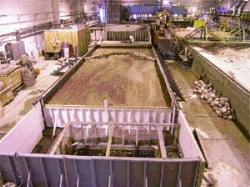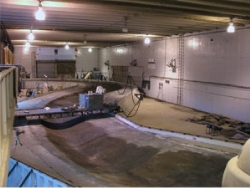Hydraulic Engineering, Stream Restoration & River Mechanics
Facilities & Resources:
The Hydraulic Engineering, Stream Restoration, and River Mechanics Program has numerous available resources that enhance graduate studies and research. Most graduate students in this program have desks in Daryl B. Simon Building at the Engineering Research Center. In this facility, students have access to state-of-the-art computing facilities for numerical modeling and data analysis. Additional computing resources are available from Engineering Network Services, who maintain several computer laboratories in the Engineering building as well as centralized networks and grids on workstations that are capable of processing very computationally intensive procedures.

World-class experimental facilities are also available to students in this program. The indoor research facility at the Engineering Research Center houses a hydraulic laboratory 280 ft x 120 ft in size. Permanent laboratory features include numerous tilting and non-tilting flumes of different discharge capabilities. An 8 ft wide x 4 ft deep x 200 ft long automatic tilting flume with discharge capacity of more than 100 cfs is available. Another 100 ft x 20 ft river basin flume allows meander, erosion, and control structure studies. The laboratory also contains a large local scour study flume and several other tilting flumes.
A 100-acre outdoor laboratory adjoins these facilities. It allows large-scale model and full-scale prototype hydraulic studies. The outdoor laboratory features a concrete flume 4 ft deep x 20 ft wide x 180 ft long with a recessed section 8 ft deep. The laboratory also houses a 3 ft diameter pipe that is 825 ft long, with variable slope arrangement.

A nearby 70 ft x 192 ft building houses the hydromachinery laboratory. This facility allows students to undertake highly specialized engineering investigations to study theoretical and applied problems of turbines and hydromachinery.
The U.S. Bureau of Reclamation’s Horsetooth Reservoir can be utilized as a water supply for both the indoor and outdoor laboratories. The reservoir provides a static head of over 200 ft and discharges up to approximately 125 cfs. Large stationary and mobile pumps are available to recirculate water at any desirable discharge and head.
These facilities provide a unique opportunity to study problems requiring large discharges, large heads, and high Reynolds numbers. In addition, the laboratory is in close proximity to lined supply channels, steep mountain streams, flat sand channel streams of the plains, and large storage reservoirs. These facilities make possible hydraulic studies in prototype scale situations and are especially helpful in certain types of model, geomorphic, sedimentation, and environmental studies, and many applied engineering problems. The Rainfall Erosion Facility offers a controlled environment to study erosion processes at a variety of scales.